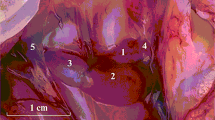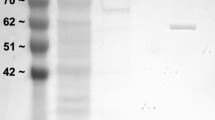Summary
Energy metabolism during anaerobiosis was investigated in the isolated posterior adductor muscle of the sea mussel. Metabolism appeared to be similar to that observed in the intact organism. Glycogen and aspartate are simultaneously utilized and levels of alanine, succinate, strombine and octopine increase. The sum of the adenylates remains constant, whereas phosphoarginine is dephosphorylated. The influence of iodoacetate, aminooxyacetate and hadacidin, inhibitors of glycolysis, transamination and purine nucleotide cycle, respectively, on the utilization of substrates and the interconversion of metabolites has been studied. The results suggest that the purine nucleotide cycle is not involved in the inverse correlation of changes in levels of aspartate and alanine, but that this exclusively depends on transamination reactions. Pyruvate (required for alanine formation) arises about equally from glycolysis and aspartate decarboxylation. When the utilization of aspartate is blocked by aminooxyacetate, glycolytically formed pyruvate is metabolized by reductive condensation with glycine and arginine to yield strombine and octopine. Under this condition phosphoarginine is dephosphorylated at a faster rate in order to maintain the energy status of the cell.
Similar content being viewed by others
Abbreviations
- Ac :
-
acetate
- AEC :
-
Atkinson energy charge
- Ala :
-
alanine
- Asp :
-
aspartate
- Glu :
-
glutamate
- Lac :
-
lactate
- Mal :
-
malate
- Oct :
-
octopine
- PA :
-
phosphoarginine
- Prop :
-
propionate
- Pyr :
-
pyruvate
- Str :
-
strombine
- Suc :
-
succinate
References
Aragón JJ, Lowenstein JM (1980) The purine-nucleotide cycle. Eur J Biochem 110:371–377
Baginski RM, Pierce SK Jr (1978) A comparison of amino acid accumulation during high salinity adaptation with anaerobic metabolism in the ribbed mussel,Modiolus demissus demissus. J Exp Zool 203:419–428
Bernt E, Bergmeyer HU (1974)l-Glutamate. In: Bergmeyer HU (ed) Methods of enzymatic analysis. Academic Press, New York London, pp 1704–1708
Bergmeyer HU, Bernt E, Möllering H, Pfleiderer G (1974)l-Aspartate andl-asparagine. In: Bergmeyer HU (ed) Methods of enzymatic analysis. Academic Press, New York London, pp 1696–1700
Bishop SH, Greenwalt DE, Burcham JM (1981) Amino acid cycling in ribbed mussel tissues subjected to hyperosmotic shock. J Exp Zool 215:277–287
Campbell JW, Vorhaben JE (1979) The purine nucleotide cycle inHelix hepatopancreas. J Comp Physiol 129:137–144
Collicutt JM, Hochachka PW (1977) The anaerobic oyster heart: Coupling of glucose and aspartate fermentation. J Comp Physiol 115:147–157
Czok R, Lamprecht W (1974) Pyruvate, phosphoenolpyruvate andd-glycerate-2-phosphate. In: Bergmeyer HU (ed) Methods of enzymatic analysis. Academic Press, New York London, pp 1446–1451
Ebberink RHM, Zurburg W, Zandee DI (1979) The energy demand of the posterior adductor muscle ofMytilus edulis in catch during exposure to air. Mar Biol Lett 1:23–31
Ellington WR (1981) Energy metabolism during hypoxia in the isolated perfused ventricle of the whelk,Busycon contrarium Conrad. J Comp Pysiol 142:457–464
Felbeck H (1980) Investigations on the role of the amino acids in anaerobic metabolism of the lugwormArenicola marina L. J Comp Physiol 137:183–192
Fonseca-Wollheim F de (1973) Bedeutung von Wasserstoffionenkonzentration und ADP-Zusatz bei der Ammoniakbestimmung mit Glutamat-Dehydrogenase. Z Klin Chem Klin Biochem 11:421–425
Gutmann I, Wahlefeld AW (1974)l-(−)Malate. In: Bergmeyer HU (ed) Methods of enzymatic analysis. Academic Press, New York London, pp 1585–1589
Holwerda DA, Zwaan A de (1980) On the role of fumarate reductase in anaerobic carbohydrate catabolism ofMytilus edulis L. Comp Biochem Physiol [B] 67:447–453
Jamieson DD, Rome P de (1979) Energy metabolism of the heart of the molluscTapes watlingi. Comp Biochem Physiol [B] 63:399–405
Jaworek D, Gruber W, Bergmeyer HU (1974) Adenosine 5-triphosphate. In: Bergmeyer HU (ed) Methods of enzymatic analysis. Academic Press, New York London, pp 2097–2101
Kmetec E (1966) Spectrophotometric method for the enzyme microdetermination of succinic acid. Anal Biochem 16:474–480
Lamprecht W, Stein P, Heinz F, Weisser H (1974) Creatine phosphate. In: Bergmeyer HU (ed) Methods of enzymatic analysis. Academic Press, New York London, pp 1777–1785
Lowenstein JM (1972) Ammonia production in muscle and other tissues: the purine nucleotide cycle. Physiol Rev 52:382–414
Meinardus G, Gäde G (1981) Anaerobic metabolism of the cockle,Cardium edule. IV. Time dependent changes of metabolites in the foot and gill tissue induced by anoxia and electrical stimulation. Comp Biochem Physiol [B] 70:271–277
Shigeura HT, Gordon CN (1962) The mechanism of action of hadacidin. J Biol Chem 237:1937–1940
Williamson DH (1974)l-Alanine. In: Bergmeyer HU (ed) Methods of enzymatic analysis. Academic Press, New York London, pp 1679–1682
Zebe E (1975) In vivo-Untersuchungen über den Glucose-Abbau beiArenicola marina (Annelida, Polychaeta). J Comp Physiol 101:133–145
Zurburg W, Ebberink RHM (1981) The anaerobic energy demand ofMytilus edulis. Organ specific differences in ATP-supplying processes and metabolic routes. Mol Physiol 1:153–164
Zurburg W, Kluytmans JH (1980) Organ specific changes in energy metabolism due to anaerobiosis in the sea musselMytilus edulis L. Comp Biochem Physiol [B] 67:317–322
Zwaan A de, Marrewijk JA van (1973) Intracellular localization of pyruvate carboxylase, phosphoenolpyruvate carboxykinase and ‘malic enzyme’ and the absence of glyoxylate cycle enzymes in the sea mussel (Mytilus edulis L). Comp Biochem Physiol [B] 44:1057–1066
Zwaan A de, Zurburg W (1981) The formation of strombine in the adductor muscle of the sea musselMytilus edulis L. Mar Biol Lett 2:179–192
Zwaan A de, Bayne BL, Bont AMT de, Livingstone DR, Zurburg W (1981) Metabolism of pyruvate during shell valve closure and subsequent recovery in the sea musselMytilus edulis. Proc 3rd Congr ESCPB, 124–125
Author information
Authors and Affiliations
Rights and permissions
About this article
Cite this article
de Zwaan, A., de Bont, A.M.T. & Verhoeven, A. Anaerobic energy metabolism in isolated adductor muscle of the sea musselMytilus edulis L.. J Comp Physiol B 149, 137–143 (1982). https://doi.org/10.1007/BF00735724
Accepted:
Issue Date:
DOI: https://doi.org/10.1007/BF00735724




